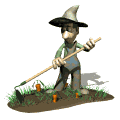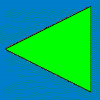The Ark Brought Into the Temple
Comments for Study 6
Pick to read this Bible passage in a separate window.
MAPS OF ISRAEL AND JUDAH
A MAP OF THE DIVISION OF CANAAN
A MAP OF THE UNITED KINGDOM OF ISRAEL
A MAP OF JERUSALEM AND THE TEMPLE
OLD TESTAMENT BOOKS TIMELINE
A LIST OF ISRAEL'S KINGS AND PROPHETS
A TIMELINE OF ISRAEL'S HISTORY
I. Two Palaces and a Hall of Justice (7:1-12)
>1. Which took longer to built, the temple or Solomon's palace? (1; 6:38)
* 1 Kings 7:1 "It took Solomon thirteen years, however, to complete the construction of his palace."
* 1 Kings 6:38 "In the eleventh year in the month of Bul, the eighth month, the temple was finished in all its details according to its specifications. He had spent seven years building it."
*
*
>Draw a proportional sketch of his palace as described in verses 2-6.
* 1 Kings 7:2-6 "He built the Palace of the Forest of Lebanon a hundred cubits long, fifty wide and thirty high, with four rows of cedar columns supporting trimmed cedar beams. It was roofed with cedar above the beams that rested on the columns--forty-five beams, fifteen to a row. Its windows were placed high in sets of three, facing each other. All the doorways had rectangular frames; they were in the front part in sets of three, facing each other. He made a colonnade fifty cubits long and thirty wide. In front of it was a portico, and in front of that were pillars and an overhanging roof."
*
*
*
*
>Consider his priorities and then where you spend your time? (Matt. 6:33-34, 20:1-2; Luke 9:57-58)
* Matthew 6:33-34 "But seek first his kingdom and his righteousness, and all these things will be given to you as well. Therefore do not worry about tomorrow, for tomorrow will worry about itself. Each day has enough trouble of its own."
* Matthew 20:1-2 "For the kingdom of heaven is like a landowner who went out early in the morning to hire men to work in his vineyard. He agreed to pay them a denarius for the day and sent them into his vineyard."
* Luke 9:57-58 "As they were walking along the road, a man said to him, "I will follow you wherever you go." Jesus replied, "Foxes have holes and birds of the air have nests, but the Son of Man has no place to lay his head."
*
*
>2. Why would he need a Hall of Justice? (7; Exodus 18:26; and 2 Sam. 15:2)
* 1 Kings 7:7 "He built the throne hall, the Hall of Justice, where he was to judge, and he covered it with cedar from floor to ceiling."
* Exodus 18:26 "They served as judges for the people at all times. The difficult cases they brought to Moses, but the simple ones they decided themselves."
* 2 Samuel 15:2 "He would get up early and stand by the side of the road leading to the city gate. Whenever anyone came with a complaint to be placed before the king for a decision, Absalom would call out to him, "What town are you from?" He would answer, "Your servant is from one of the tribes of Israel."
*
*
>How are Christians to decide things? (Acts 14:23; and 1 Cor. 6:1-4)
* Acts 14:23 "Paul and Barnabas appointed elders for them in each church and, with prayer and fasting, committed them to the Lord, in whom they had put their trust."
* 1 Corinthians 6:1-4 "If any of you has a dispute with another, dare he take it before the ungodly for judgment instead of before the saints? Do you not know that the saints will judge the world? And if you are to judge the world, are you not competent to judge trivial cases? Do you not know that we will judge angels? How much more the things of this life! Therefore, if you have disputes about such matters, appoint as judges even men of little account in the church!"
*
*
*
>3. Who did he build a second palace for? (8)
* 1 Kings 7:8 "And the palace in which he was to live, set farther back, was similar in design. Solomon also made a palace like this hall for Pharaoh's daughter, whom he had married."
*
*
*
*
>How does Solomon having a walled in courtyard differ from his father? (9-12)
* 1 Kings 7:9-12 "All these structures, from the outside to the great courtyard and from foundation to eaves, were made of blocks of high-grade stone cut to size and trimmed with a saw on their inner and outer faces. The foundations were laid with large stones of good quality, some measuring ten cubits and some eight. Above were high-grade stones, cut to size, and cedar beams. The great courtyard was surrounded by a wall of three courses of dressed stone and one course of trimmed cedar beams, as was the inner courtyard of the temple of the LORD with its portico."
*
*
*
*
II. The Temple's Furnishings (7:13-51)
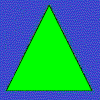
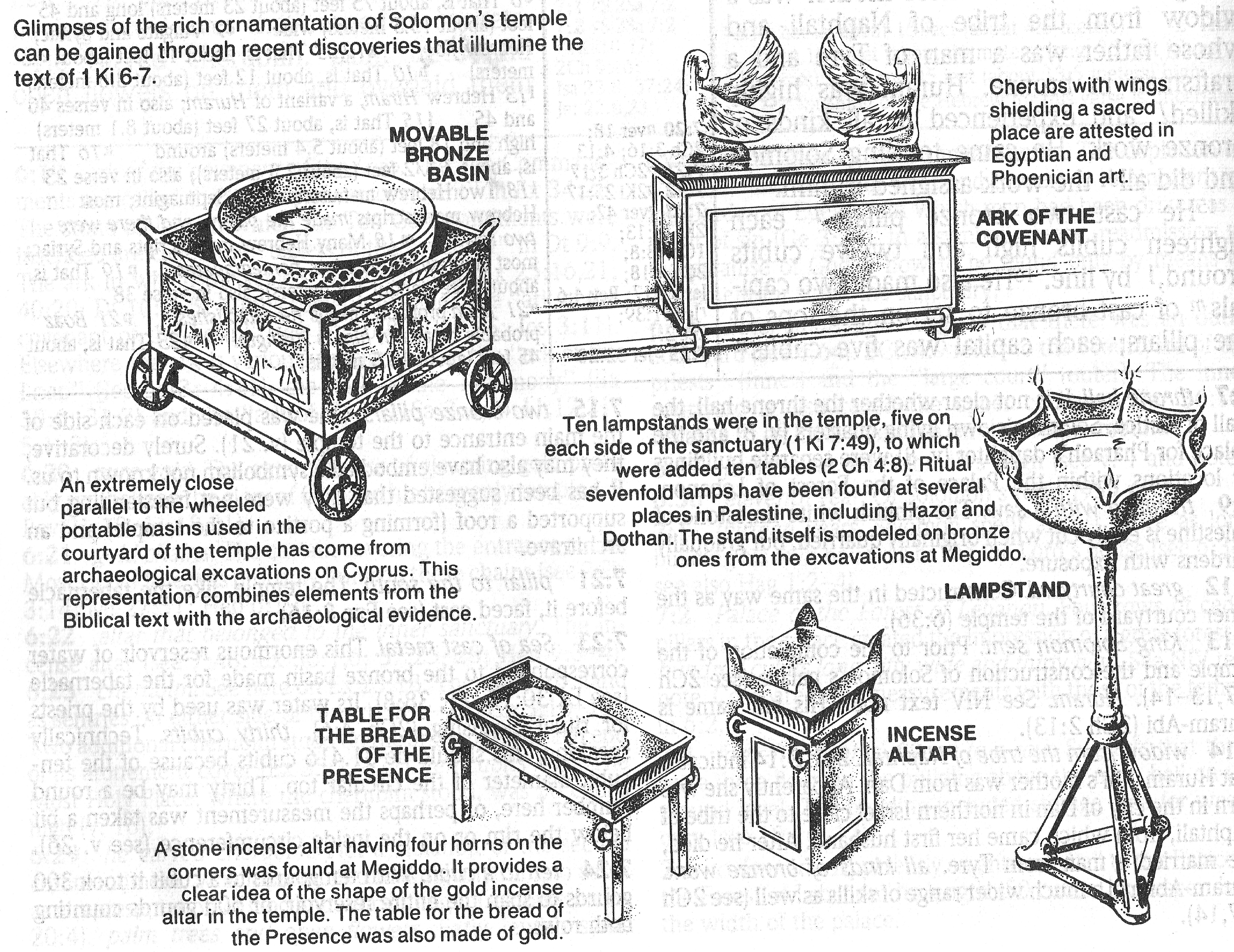
* See drawings of the temple furnishings to the right from the NIV Study Bible. Glimpses of the rich ornamentation of Solomon's temple can be gained through recent discoveries that illumine the text of 1 Kings 6-7 and 2 Chronicles 1-4.
>4. Who did Solomon hire? (13-14)
* 1 Kings 7:13-14 "King Solomon sent to Tyre and brought Huram, whose mother was a widow from the tribe of Naphtali and whose father was a man of Tyre and a craftsman in bronze. Huram was highly skilled and experienced in all kinds of bronze work. He came to King Solomon and did all the work assigned to him."
* "sent to Tyre and brought Huram" -The book of Kings states Solomon's request for a master craftsman late in the narrative (1 Kings 7:13). To carry out the parallel between Oholiab and Huram-Abi, the Chronicler(s) includes it in the initial correspondance. Furthermore, in 2 Chronicles 2:7, 13-14 the list of Huram-Abi's skills is expanded and matches that of Bezalel and Oholiab. (Kings is concerned only with casting bronze.)
* "Huram-Abi" -Kings reports that the ancestry of Huram-Abi was through a widow of Naphtali. Chronicles 2:13 strenthens the parallel between Huram-Abi and Oholiab by assignng him Danite ancestry. These statements are not neccissarily contradictory:
1. The mother's ancestry may have been Danite, though she lived in the territory of Naphtali.
2. Her parents may have been from Dan and Naphtali, allowing her descent to be reckoned to either. The Danites had been previously associated with the Phoenicians (Judges 18:7).
* The inside of the temple was filled with glistening polished gold. Even a small amount of light would reflect brightly. The finest materials were crafted into precise finely decorated usable shapes. All were made to represent the Lord God's throne in heaven. The magnificent temple was a place where people could present themselves to the invisible, powerful, glorious maker of the universe.
My soul is now the temple of God. The Spirit of God dwells in my being. I am to submit to God so my life, my being, my character, my heart, and my mind are to be an acceptable place for God to dwell. The attention to every detail is to be God's exacting standard. I am a living stone being built into a spiritual house to be a holy priest, offering spiritual sacrifices acceptable to God through Jesus Christ. (1 Peter 2:5)
My purifying would not be possible without Jesus' sacrifice for me. Jesus' death makes me acceptable to God. In view of God's mercy, I submit my body as a living sacrifice holy, pleasing, and acceptable to God as my spiritual act of worship. (Romans 12:1)
*
* 1 Peter 2:4-6 "As you come to him, the living Stone--rejected by men but chosen by God and precious to him-- you also, like living stones, are being built into a spiritual house to be a holy priesthood, offering spiritual sacrifices acceptable to God through Jesus Christ. For in Scripture it says: "See, I lay a stone in Zion, a chosen and precious cornerstone, and the one who trusts in him will never be put to shame."
* Romans 12:1-2 "Therefore, I urge you, brothers, in view of God's mercy, to offer your bodies as living sacrifices, holy and pleasing to God--this is your spiritual act of worship. Do not conform any longer to the pattern of this world, but be transformed by the renewing of your mind. Then you will be able to test and approve what God's will is--his good, pleasing and perfect will."
*
* The details of the construction of all the items used in the temple are mostly recorded in Chronicles though 1 Kings 6:14-38 and 7:13-51 mentions some of the work. Since the two books of Chronicles (two scrolls) were written sometime shortly after the Jews returned from exile in Babylon and Assyria and before the temple was rebuilt it is understandable why the Lord chose to give them this account. Much of the information was collected from other scrolls besides 1 Kings 7.
Huram-Abi is mentioned many times in chapters 2 thru 4 and 1 Kings 7. He was half Israelite since his mother was a Naphtali and his father a man of Tyre (1 Kings 7:13). He was not a Jew. He was from Tyre, and thus a Phoenician. He was sent to King Solomon to work on the temple.
The linage of the man whom God chose to construct and mold all the elegant and important bronze articles used in the temple is interesting to me. When the Jews returned from captivity they refused the let the people who were in Judah and Israel during the exile to work on the rebuilding of the temple (Ezra 4). They are called enemies of Judah and Benjamin (Ezra 4:1). Yet Solomon not only allowed others to build the first temple in Jerusalem but welcomed and needed Huram.
There is a time for everything under the sun. A person's linage is not important as his or her charactor. Often God uses the most unlikely person to do the most critical and much-needed tasks.
*
*
*
>What might be the purpose of the decorated pillars? (15-22)
* 1 Kings 7:15-22 He cast two bronze pillars, each eighteen cubits high and twelve cubits around, by line. He also made two capitals of cast bronze to set on the tops of the pillars; each capital was five cubits high. A network of interwoven chains festooned the capitals on top of the pillars, seven for each capital. He made pomegranates in two rows encircling each network to decorate the capitals on top of the pillars. He did the same for each capital. The capitals on top of the pillars in the portico were in the shape of lilies, four cubits high. On the capitals of both pillars, above the bowl-shaped part next to the network, were the two hundred pomegranates in rows all around. He erected the pillars at the portico of the temple. The pillar to the south he named Jakin and the one to the north Boaz. The capitals on top were in the shape of lilies. And so the work on the pillars was completed."
*
*
*
*
>Of the Sea? (23-26)
* 1 Kings 7:23-26 "He made the Sea of cast metal, circular in shape, measuring ten cubits from rim to rim and five cubits high. It took a line of thirty cubits to measure around it. Below the rim, gourds encircled it--ten to a cubit. The gourds were cast in two rows in one piece with the Sea. The Sea stood on twelve bulls, three facing north, three facing west, three facing south and three facing east. The Sea rested on top of them, and their hindquarters were toward the center. It was a handbreadth in thickness, and its rim was like the rim of a cup, like a lily blossom. It held two thousand baths."
*
*
*
*
>Of the stands? (27-37)
* 1 Kings 7:27-37 "He also made ten movable stands of bronze; each was four cubits long, four wide and three high. This is how the stands were made: They had side panels attached to uprights. On the panels between the uprights were lions, bulls and cherubim--and on the uprights as well. Above and below the lions and bulls were wreaths of hammered work. Each stand had four bronze wheels with bronze axles, and each had a basin resting on four supports, cast with wreaths on each side. On the inside of the stand there was an opening that had a circular frame one cubit deep. This opening was round, and with its basework it measured a cubit and a half. Around its opening there was engraving. The panels of the stands were square, not round. The four wheels were under the panels, and the axles of the wheels were attached to the stand. The diameter of each wheel was a cubit and a half. The wheels were made like chariot wheels; the axles, rims, spokes and hubs were all of cast metal. Each stand had four handles, one on each corner, projecting from the stand. At the top of the stand there was a circular band half a cubit deep. The supports and panels were attached to the top of the stand. He engraved cherubim, lions and palm trees on the surfaces of the supports and on the panels, in every available space, with wreaths all around. This is the way he made the ten stands. They were all cast in the same molds and were identical in size and shape."
*
*
*
*
>Of the basins and shovels and sprinkling bowls? (38-47)
* 1 Kings 7:38-47 "He then made ten bronze basins, each holding forty baths and measuring four cubits across, one basin to go on each of the ten stands. He placed five of the stands on the south side of the temple and five on the north. He placed the Sea on the south side, at the southeast corner of the temple. He also made the basins and shovels and sprinkling bowls. So Huram finished all the work he had undertaken for King Solomon in the temple of the LORD: the two pillars; the two bowl-shaped capitals on top of the pillars; the two sets of network decorating the two bowl-shaped capitals on top of the pillars; the four hundred pomegranates for the two sets of network (two rows of pomegranates for each network, decorating the bowl-shaped capitals on top of the pillars); the ten stands with their ten basins; the Sea and the twelve bulls under it; the pots, shovels and sprinkling bowls. All these objects that Huram made for King Solomon for the temple of the LORD were of burnished bronze. The king had them cast in clay molds in the plain of the Jordan between Succoth and Zarethan. Solomon left all these things unweighed, because there were so many; the weight of the bronze was not determined."
*
*
*
*
>5. What other things did he make? (48-50)
* 1 Kings 7:48-50 "Solomon also made all the furnishings that were in the LORD's temple: the golden altar; the golden table on which was the bread of the Presence; the lampstands of pure gold (five on the right and five on the left, in front of the inner sanctuary); the gold floral work and lamps and tongs; the pure gold basins, wick trimmers, sprinkling bowls, dishes and censers; and the gold sockets for the doors of the innermost room, the Most Holy Place, and also for the doors of the main hall of the temple."
*
*
*
*
>Compare them to the furnishings of the tabernacle. (Ex. 27:1-8, 20-21, 30:1-6, 17-21)
*
*
*
*
*
>What else was put in the temple? (51)
* 1 Kings 7:51 "When all the work King Solomon had done for the temple of the LORD was finished, he brought in the things his father David had dedicated--the silver and gold and the furnishings--and he placed them in the treasuries of the LORD's temple."
*
*
*
*
III. The Glory of the Lord Filled the Temple (8:1-21)

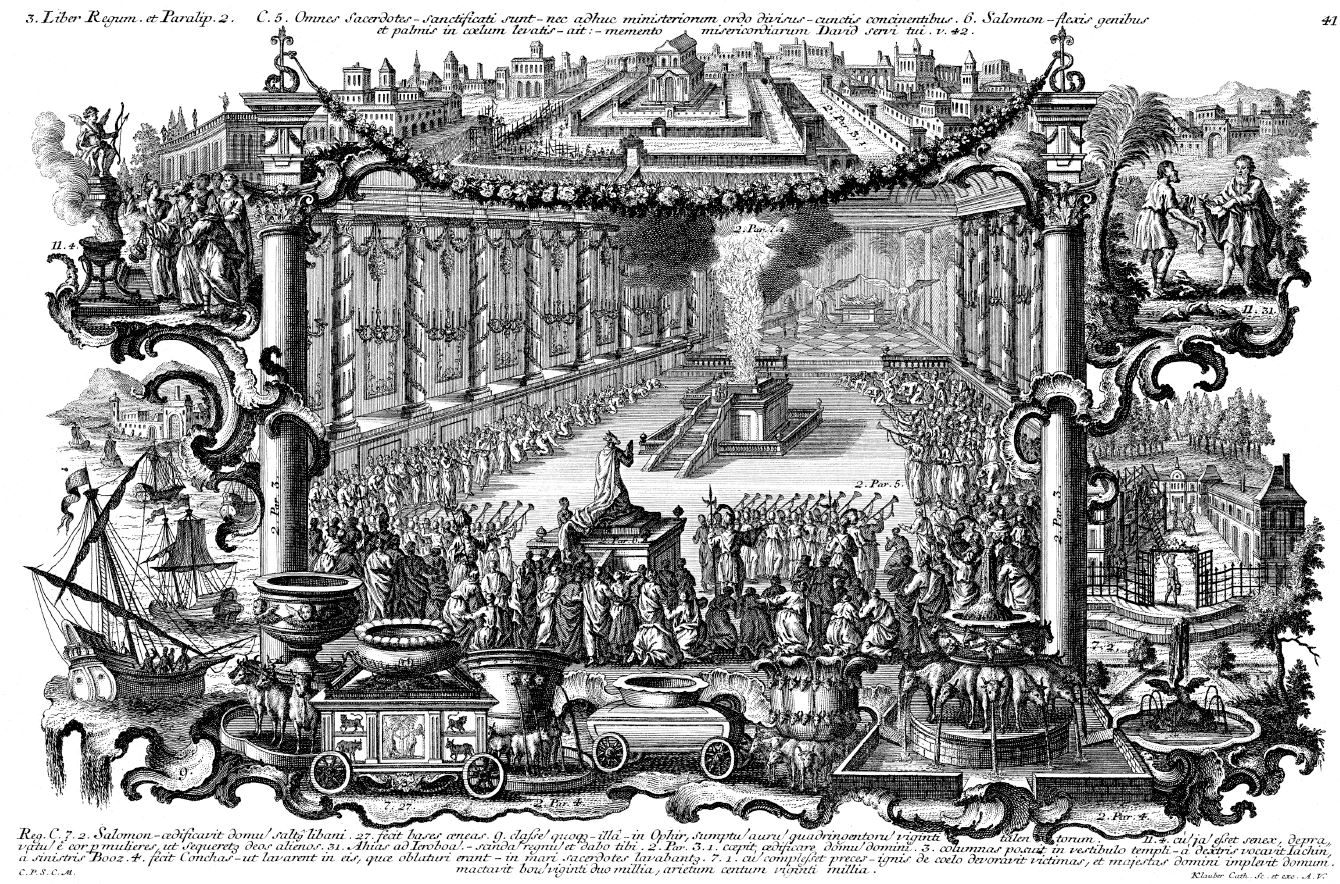
* See a drawing by Joseph Sebastian (1700-1768) to the right depicts the dedication of the Temple in Jerusalem. The leaders of Israel gather as Solomon sacrifices a burnt-offering, and fire comes down from heaven to consume the sacrifice. At the top Solomon begins to build the house of the Lord in Jerusalem. At the bottom are the utensils of the Temple including the cast sea, the bronze stand and the basin. In the bottom-right corner is the palace of Solomon. In the bottom-left corner is Solomom's fleet. In the top-left corner Solomon worships at the altar to a foreign god. In the top-right corner Ahijah meets Jeroboam on the road and tells him that he will be given the kingdom of Israel. As a prophetic sign, Ahijah tears his new garment into twelve pieces and tells Jeroboam to take ten, representing the ten tribes of Israel that he will be given. Courtesy of the Digital Image Archive, Pitts Theology Library, Candler School of Theology, Emory University: http://www.pitts.emory.edu.
>6. For what event were all the elders of Israel required to attend? (1)
* 1 Kings 8:1 "Then King Solomon summoned into his presence at Jerusalem the elders of Israel, all the heads of the tribes and the chiefs of the Israelite families, to bring up the ark of the LORD's covenant from Zion, the City of David."
* 2 Chronicles 5 also record the Ark of the Covenent being brought into the temple.
*
*
*
>When was it? (2; Lev. 23:23-27, 33-34)
* 1 Kings 8:2 "All the men of Israel came together to King Solomon at the time of the festival in the month of Ethanim, the seventh month."
* "the festival in the month of Ethanim, the seventh month" -The Feast of Tabernacles is in the Hebrew calendar seventh month. The month is designated by its Canaanite name Ethanim here. The Hebrew name is Tishri. According to 1 Kings 6:38 the temple was completed in the eighth month of Solomon's 11th year (Sept.-Oct. 959 B.C.) This celebration of dedication took place either a month before the completion of the work or 11 months after, probably the later.
* Leviticus 23:23-27 "The LORD said to Moses, "Say to the Israelites: 'On the first day of the seventh month you are to have a day of rest, a sacred assembly commemorated with trumpet blasts. Do no regular work, but present an offering made to the LORD by fire.'" The LORD said to Moses, "The tenth day of this seventh month is the Day of Atonement. Hold a sacred assembly and deny yourselves, and present an offering made to the LORD by fire."
* Leviticus 23:33-34 "The LORD said to Moses, "Say to the Israelites: 'On the fifteenth day of the seventh month the LORD's Feast of Tabernacles begins, and it lasts for seven days."
*
*
>7. Who carried the ark and the tabernacle and why them? (3-5; Num. 4:15; and 1 Chron. 15:15; and 2 Sam. 6:6-7)
* 1 Kings 8:3-5 "When all the elders of Israel had arrived, the priests took up the ark, and they brought up the ark of the LORD and the Tent of Meeting and all the sacred furnishings in it. The priests and Levites carried them up, and King Solomon and the entire assembly of Israel that had gathered about him were before the ark, sacrificing so many sheep and cattle that they could not be recorded or counted."
* Numbers 4:15 "After Aaron and his sons have finished covering the holy furnishings and all the holy articles, and when the camp is ready to move, the Kohathites are to come to do the carrying. But they must not touch the holy things or they will die. The Kohathites are to carry those things that are in the Tent of Meeting.'
* 1 Chronicles 15:15 "And the Levites carried the ark of God with the poles on their shoulders, as Moses had commanded in accordance with the word of the Lord."
* 2 Samuel 6:6-7 "When they came to the threshing floor of Nacon, Uzzah reached out and took hold of the ark of God, because the oxen stumbled. The LORD's anger burned against Uzzah because of his irreverent act; therefore God struck him down and he died there beside the ark of God."
*
*
*
>Where did they place the ark? (6-8)
* 1 Kings 8:6-8 "The priests then brought the ark of the LORD's covenant to its place in the inner sanctuary of the temple, the Most Holy Place, and put it beneath the wings of the cherubim. The cherubim spread their wings over the place of the ark and overshadowed the ark and its carrying poles. These poles were so long that their ends could be seen from the Holy Place in front of the inner sanctuary, but not from outside the Holy Place; and they are still there today."
* "carrying poles" -The carrying poles were always to remain in the gold rings of the ark (Exodus 25:25).
* "still there today" -These words must be those of the original author of this description of the dedication of the temple rather than those of the final compiler of the books of Kings.
*
*
*
*
>What was the significance of the two stone tablets? (9; Deut. 5:22)
* 1 Kings 8:9 "There was nothing in the ark except the two stone tablets that Moses had placed in it at Horeb, where the LORD made a covenant with the Israelites after they came out of Egypt."
* Deuteronomy 5:22 "These are the commandments the LORD proclaimed in a loud voice to your whole assembly there on the mountain from out of the fire, the cloud and the deep darkness; and he added nothing more. Then he wrote them on two stone tablets and gave them to me."
* Exodus 31:18 "When the LORD finished speaking to Moses on Mount Sinai, he gave him the two tablets of the Testimony, the tablets of stone inscribed by the finger of God."
* Exodus 34:4 "So Moses chiseled out two stone tablets like the first ones and went up Mount Sinai early in the morning, as the LORD had commanded him; and he carried the two stone tablets in his hands."
* "nothing in the ark except the two tablets that Moses had placed in it" -Exodus 16:32-34, 31:18, 32:15-16 and Numbers 17:10-11 record the ark had earlier also contained the gold jar of manna and Aaron's staff. These items were presumably lost, perhaps while the ark was in Philistine hands.
* "two stone tablets" -The stone tablets had etched in them the 10 commands of the covenant between the Lord and Israel.
>8. What happened when the priests left the Holy Place? (10-13)
* 1 Kings 8:10-13 "When the priests withdrew from the Holy Place, the cloud filled the temple of the LORD.
11 And the priests could not perform their service because of the cloud, for the glory of the LORD filled his temple.
12 Then Solomon said, "The LORD has said that he would dwell in a dark cloud;
13 I have indeed built a magnificent temple for you, a place for you to dwell forever."
* 1 Chronicles 5:11-14 also records what happened when the ark was placed into the temple and 1 Chronicles 7:1-3 records what happened after Solomon prayed. Chronicles 7:1-3 is not found in Kings.
* The pomp and grandeur of the procession that brought the Ark of the covenant from the tent that David constructed in Jerusalem to the finished temple are depicted in 2 Chronicles 5 and 1 Kings 8. David with all his passion, Solomon with all his wisdom, Harum with all his skill, and Israel with all their wealth did their best to make the celebration an event to honor God. However, when the glory (kabod in Hebrew) of the LORD filled the temple of God all men were truly humbled and elevated (14,15).
The LORD God is surrounded by light too luminous for humans to gaze upon without losing their eyesight. Thus, all those who have gazed upon the Lord's radiant and brilliant wonder shielded their eyes. The glory of the Lord came on Mt. Sinai just after the Lord led the Israelites out of Egypt (Ex. 16:7-10, 24:16-17), in desert Tabernacle (Ex. 40:34-38; Lev. 9:6, 23; Num. 14:10), and in the Temple in Jerusalem (1 Kings 8:10-11; and 2 Chronicles 5:14, 7:1-3, Isa. 6:1-4).
Jesus prophesied to the Sanhedrin after he declared that he is the Messiah, "And you will see the Son of Man sitting at the right hand of the Mighty One and coming on the clouds of heaven." (Mark 14:16) Jesus coming in the glory of the Lord is prophecies by Isaiah (Isaiah 4:2-6, 35:1-2, 40:4-5, 59:19-20, 60). Ezekiel also saw the glory of the Lord. (Ezekiel 1:25-28; 3:12, 22-23; 9:3-4; 10:3-4, 18-22; 11:22-23; 43:1-5; 44:4).
Luke 2:9 says the glory of the Lord shown over the shepherds when the angels said Jesus was born. Paul calls Jesus the "Lord of glory" in 1 Corinthians 2:8 and the "radiance of God's glory" in Hebrews 1:3.
Jesus is my friend and shepherd. More than these he is also my master, my God, and my Lord. Reverence and fear of the Lord is known by those who draw close to his glory.
*
*
>When had the Lord revealed himself like this before? (Exodus 19:16-19, 40:34-38, Lev. 9:23-24, Num. 9:15-16, 11:1, 20:6)
* Exodus 19:16-19 "On the morning of the third day there was thunder and lightning, with a thick cloud over the mountain, and a very loud trumpet blast. Everyone in the camp trembled. Then Moses led the people out of the camp to meet with God, and they stood at the foot of the mountain. Mount Sinai was covered with smoke, because the LORD descended on it in fire. The smoke billowed up from it like smoke from a furnace, the whole mountain trembled violently, and the sound of the trumpet grew louder and louder. Then Moses spoke and the voice of God answered him."
* Exodus 40:34-38 "Then the cloud covered the Tent of Meeting, and the glory of the LORD filled the tabernacle. Moses could not enter the Tent of Meeting because the cloud had settled upon it, and the glory of the LORD filled the tabernacle. In all the travels of the Israelites, whenever the cloud lifted from above the tabernacle, they would set out; but if the cloud did not lift, they did not set out--until the day it lifted. So the cloud of the LORD was over the tabernacle by day, and fire was in the cloud by night, in the sight of all the house of Israel during all their travels."
* Leviticus 9:23-24 "Moses and Aaron then went into the Tent of Meeting. When they came out, they blessed the people; and the glory of the LORD appeared to all the people. Fire came out from the presence of the LORD and consumed the burnt offering and the fat portions on the altar. And when all the people saw it, they shouted for joy and fell facedown."
* Numbers 9:15-16 "On the day the tabernacle, the Tent of the Testimony, was set up, the cloud covered it. From evening till morning the cloud above the tabernacle looked like fire. That is how it continued to be; the cloud covered it, and at night it looked like fire."
* Numbers 11:1 "Now the people complained about their hardships in the hearing of the LORD, and when he heard them his anger was aroused. Then fire from the LORD burned among them and consumed some of the outskirts of the camp."
* Numbers 20:6 "Moses and Aaron went from the assembly to the entrance to the Tent of Meeting and fell facedown, and the glory of the LORD appeared to them."
*
>When was the last recorded time the Israelites had saw glory of the Lord before the temple's dedication? (1 Sam. 4:22)
* * 1 Samuel 4:22 "She said, 'The glory has departed from Israel, for the ark of God has been captured.'"
* 2 Chronicles 7:3 "When all the Israelites saw the fire coming down and the glory of the LORD above the temple, they knelt on the pavement with their faces to the ground, and they worshiped and gave thanks to the LORD, saying, "He is good; his love endures forever."
* The manifestation the Lord God gave Israel to show his acceptance of their dedication ceremony and the temple they built was extraordinary. Fire came down from heaven and consumed the burnt offering and the sacrifices (1). Also, the glory of the LORD filled the temple as it had since the start of the dedication ceremony when they brought the ark into the temple (1, 5:14)
The people's response reveals their hearts and attitudes. When they saw all that had happened they knelt on the pavement with their faces to the ground, and they worshiped and gave thanks to the LORD (2). They had a change of attitude.
I suspect that they are like most people, including me when we go to a worship event. Whether it be a church service, revival, or musical performance and celebration sometimes it is more like a routine, a habit, or perhaps occasionally like a hindrance. On those days and at that time my heart is lukewarm; neither hot nor cold. I bring my body but my heart is not present.
When in that kind of mode and attitude the Lord Jesus may touch my heart or does some extraordinary thing and my demeanor changes. I am consumed by the fire of the Lord. The temple of my soul is filled with the glory of the LORD. My demeanor is transformed. My heart kneels with my face to the ground.
*
*
*
*
>9. What are the main points of Solomon's blessing? (14-21)
* 1 Kings 8:14-21 "While the whole assembly of Israel was standing there, the king turned around and blessed them. Then he said: "Praise be to the LORD, the God of Israel, who with his own hand has fulfilled what he promised with his own mouth to my father David. For he said, 'Since the day I brought my people Israel out of Egypt, I have not chosen a city in any tribe of Israel to have a temple built for my Name to be there, but I have chosen David to rule my people Israel.' My father David had it in his heart to build a temple for the Name of the LORD, the God of Israel. But the LORD said to my father David, 'Because it was in your heart to build a temple for my Name, you did well to have this in your heart. Nevertheless, you are not the one to build the temple, but your son, who is your own flesh and blood--he is the one who will build the temple for my Name.' The LORD has kept the promise he made: I have succeeded David my father and now I sit on the throne of Israel, just as the LORD promised, and I have built the temple for the Name of the LORD, the God of Israel. I have provided a place there for the ark, in which is the covenant of the LORD that he made with our fathers when he brought them out of Egypt."
*
*
*
*
>What event does this event foreshadow? (Matt. 26:64)
* Matthew 26:64 ""Yes, it is as you say," Jesus replied. "But I say to all of you: In the future you will see the Son of Man sitting at the right hand of the Mighty One and coming on the clouds of heaven."
*
*
*
*

|



